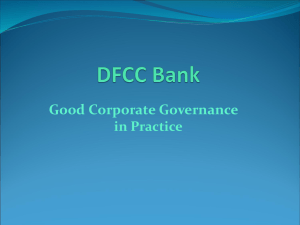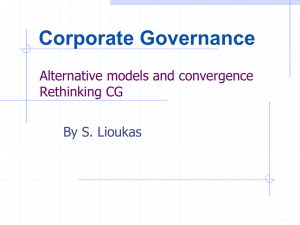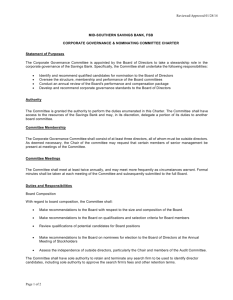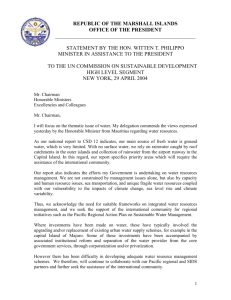PWMC
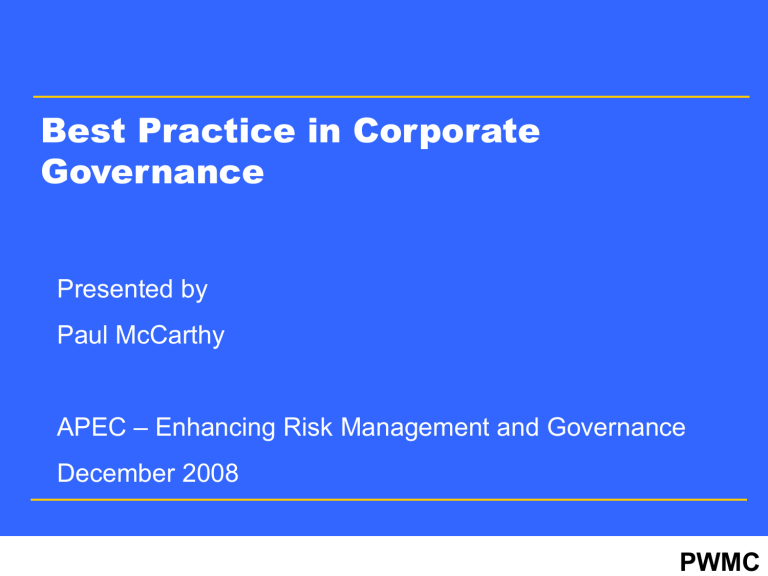
Best Practice in Corporate
Governance
Presented by
Paul McCarthy
APEC – Enhancing Risk Management and Governance
December 2008
PWMC
Agenda
Concepts
Structures
Process
People
Checklist
PWMC 2
Agenda
Concepts
Structures
Process
People
Checklist
PWMC 3
The Genesis of Corporate Governance
Corporate governance has only recently emerged as a discipline in its own right, although the strands of political economy it embraces stretch back through centuries.
The World Bank, 1999
PWMC 4
Corporate Governance – How Broad?
Our focus is on the role of the Board of directors
Reconcile separation of ownership and control
Governance is not management
PWMC 5
What do we mean by Corporate Governance?
System by which companies are directed and controlled. It influences how the objectives of the company are set and achieved, how risk is monitored and assessed and how performance is optimised.
The process by which corporations are made responsive to the rights and wishes of stakeholders.
PWMC 6
Best Practice from Australia’s Big Banks
Four major banks are AA rated (only 12 in the world)
Among the 100 biggest banks in the world
Have remained financially sound and profitable
Committed to highest standards of governance
PWMC 7
Agenda
Concepts
Structures
Process
People
Checklist
PWMC 8
Structures – the leaders
Chairman separate from CEO
In practice as well as name
Processes to obviate “dominance by personality”
PWMC 9
Structures – the Board
Mix of skills and experience (minimum size)
Efficiency in decision-making and debate (maximum size)
Compact size – about 10/12 directors
Board renewal – tenure limits and injection of new talent
PWMC 10
Structures - Independence
Majority of independent directors
Non-executive director (not current or past employee)
No association with a substantial shareholder
No connection with supplier or customer
Not past or present auditor, consultant or adviser
Objective – independence in thinking, debate & decisions
PWMC 11
Structures – Executive Directors
Compact Board size and majority independent directors
Strictly limits room for executive directors
Board’s role is to oversee management – challenge, motivate, advise
Strong case for CEO as only executive director
PWMC 12
Structures – Board Committees
Nominations Committee
Audit Committee
Remuneration Committee
Risk Committee
Nominations is only committee chaired by Board chairman
Chairs of other committees based on expertise & experience
Committee members normally all independent directors
CEO attends (as required) as executive not as director
PWMC 13
Agenda
Concepts
Structures
Process
People
Checklist
PWMC 14
The Three Dimensional Board
1. Monitor
2. Decide
3. Advise
PWMC 15
Board Process - Charters
Board charter – functions and responsibilities
Committee charters – role, objectives and powers
Delegated authorities – board, committees, CEO, staff
Accountabilities linked to authorities
Delegations policy document reviewed annually
Detailed corporate governance statement
PWMC 16
Board Process - Meetings
Meet monthly
Annual meeting plan
Agenda linked to priorities (strategy, risk & financials)
Two meetings exclusively on strategy
Audit and Risk Committees meet every 2 months
Other committees at least quarterly
Audit Committee access to head of internal auditor
Risk Committee access to chief risk officer
PWMC 17
Board Process - Ethics
Code of conduct – statement of ethical standards
Confidentiality a critical requirement
Conflicts of interest to be disclosed
Not receive papers, absent from discussion, not vote
Restrictions on share trading – “windows” & short-term
PWMC 18
Board Process – Support for Directors
Formal induction program
Directors’ handbook
Continuing education
Access to independent professional advice
PWMC 19
Board Process – Performance Evaluation
Formal annual review of Board, committees, directors
Use of external consultant every second year
Separate assessment of effectiveness of Board chairman
Assessment of quality of Board papers
Regular discussions in absence of executives (incl CEO)
PWMC 20
Agenda
Concepts
Roles
Structures
People
Checklist
PWMC 21
Essential Qualities of Directors – the 6 “i’s”
1.
Integrity
2.
Intellectual Capacity
3.
Interpersonal Skills
4.
Independent thinking
5.
Interest
6.
Intent
PWMC 22
Director selection
The Board must establish (guided by the Nominations
Committee) a set of criteria for director appointments
The aim is to create and maintain a Board capable of overseeing, challenging, stretching and motivating management
PWMC 23
The role of Directors
As defined by CBA, directors are expected to:
Operate as part of an exceptional team
Exhibit impeccable values
Input strongly to risk management, strategy and policy
Provide skills & experience required now and for the future
Be excellently prepared and receive all necessary education
Provide valuable insights and input to management
Vigorously debate and challenge management
PWMC 24
Agenda
Concepts
Structures
Process
People
Checklist
PWMC 25
Governance checklist
1.
2.
3.
4.
5.
6.
7.
8.
Beware dominant chairman or CEO
Majority of truly independent directors
Effective Board and committee structure
Responsibilities, authorities & accountabilities defined
Ethical standards prescribed
Effective Board and committee process
Agenda focussed on right priorities
Quality of Board papers and executive input
PWMC 26
Governance Checklist continued
9.
Conflict of interest provisions clear and effective
10.
Securities trading by directors strictly controlled
11.
Rigorous annual evaluation of Board performance
12.
Individual directors of high calibre (acumen & integrity)
13.
Effective mix of expertise, experience and perspective
14.
Diligent attention to Board renewal
PWMC 27
Supplementary material
1.
2.
3.
4.
5.
6.
7.
8.
The regulatory trade-off
Issues in developing markets
Responsibilities of the board
Australian banks’ attention to governance
Australian banks governance overview
Australian banks board committees
Reference material
Supplementary readings
PWMC 28
The Governance Trade-off
$
A
B
Shareholder value
C
Risk
Pre -
2000
Optimum Now
Amount of regulation
PWMC 29
Issues for Corporate Boards in Developing Markets
1. Concentration of Ownership
2. Appointment Process
3. Role Clarity
4. Information Quality
5. Local Culture
6. Legal Deficiencies
Source: The McKinsey Quarterly, 2006, Number 1
PWMC 30
Responsibilities of the Board
Corporate governance
Oversight of the business and affairs of the company, including: strategies and financial objectives approving major initiatives and capital expenditure risk management management performance
Appointment of CEO
HR policies
Reports to shareholders
PWMC 31
Australian Banks’ Attention to Governance
Corporate Governance
Statements – Number of pages
ANZ
11
CBA
8
NAB
10
WBC
17
Websites
WWW.ANZBANK.COM
WWW.COMMBANK.COM.AU
WWW.NABGROUP.COM
WWW.WESTPAC.COM.AU
PWMC 32
Australian Banks Governance Overview
Role Clarity
Non-Exec Chairman
Board Size
Non-Exec/Exec Directors
Independence Provisions
Performance Reviews
Codes of Conduct
Audit Committee
Nominations Committee
Remuneration Committee
Risk Committee
Other Committees
ANZ
√
√
9
√
√
√
8/1
√
√
√
√
Technology
√
√
√
9/1
√
√
√
√
-
CBA
√
√
10
√
√
√
11/3
√
√
√
√
-
NAB
√
√
14
WBC
√
√
9
√
√
√
8/1
√
√
√
√
Social
Responsibility
PWMC 33
Australian Banks Board Committees
Audit Committee
Board Chairman Member
Board Chairman Chair
CEO Member
Nominations Committee
Board Chairman Member
Board Chairman Chair
CEO Member
Remuneration Committee
Board Chairman Member
Board Chairman Chair
CEO Member
Risk Committee
Board Chairman Member
Board Chairman Chair
CEO Member
ANZ
√
X
X
√
X
X
√
X
X
√
X
X
CBA
√
X
X
√
X
√
X
X
X
√
√
X
NAB
X
X
X
X
X
√
X
X
X
√
√
X
WBC
√
X
X
√
X
X
√
X
X
√
√
X
PWMC 34
Reference material
OECD - Principles of Corporate Governance
OECD - White Paper on Corporate Governance in Asia
ASX Corporate Governance Council – Principles of Good
Corporate Governance and Best Practice Recommendations
Asian Development Bank Institute – Corporate Governance in Asia:
Recent evidence from Indonesia, Korea, Thailand and Malaysia
Harvard Business Review 9/02 – What Makes Great Boards Great
Harvard Business Review 3/03 – The Board’s Missing Link
The McKinsey Quarterly 02/4 – Change Across the Board
The McKinsey Quarterly 06/1 – Improving Board Performance in
Emerging Markets
The Economist 28/5/05 – The Biggest Contract
PWMC 35
Supplementary Readings (books)
Theories of Corporate Governance by Thomas Clarke
Corporate Governance and Chairmanship: A Personal
View by Sir Adrian Cadbury
Back to the Drawing Board: Designing Corporate
Boards for a Complex World by Colin Carter and Jay
Lorsch
The Recurrent Crisis in Corporate Governance by Paul
MacAvoy and Ira Millstein
PWMC 36
